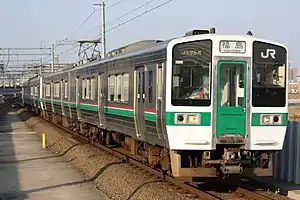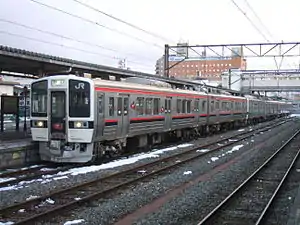| 719 series | |
|---|---|
 A 719-0 series set in the Sendai area in July 2008 | |
| Manufacturer | Nippon Sharyo, Tokyu Car Corporation |
| Constructed | 1989–1991 |
| Entered service | 5 November 1991 |
| Scrapped | 2016- |
| Number built | 108 vehicles (54 sets) |
| Number in service | 96 vehicles (48 sets) (as of 1 April 2017) |
| Formation | 2 cars per set |
| Fleet numbers | H1 – H26, H28 – H42, S27, Y1 – Y12 |
| Operators | JR East |
| Depots | Sendai, Yamagata, Akita |
| Lines served | Tohoku Main Line, Ōu Main Line, Senzan Line, Banetsu West Line |
| Specifications | |
| Car body construction | Stainless steel |
| Car length | 20,000 mm (65 ft 7 in) |
| Width | 2,950 mm (9 ft 8 in) |
| Floor height | 1,180 mm (3 ft 10 in) |
| Doors | 3 pairs per side (719-700 series has one pair per side) |
| Maximum speed | 110 km/h (70 mph) |
| Traction system | Thyristor drive |
| Electric system(s) | 20 kV AC (50 Hz) |
| Current collector(s) | overhead catenary |
| Safety system(s) | ATS-Ps (719-0 series) ATS-P (719-5000 series) |
| Track gauge | 1,067 mm (3 ft 6 in) (719-0 series) 1,435 mm (4 ft 8+1⁄2 in) (719-5000 series) |
The 719 series (719系, 719-kei) is an AC electric multiple unit (EMU) train type introduced in 1989 by East Japan Railway Company (JR East) on services in the Miyagi, Yamagata, and Fukushima areas of Japan.
Design
Built jointly by Nippon Sharyo and Tokyu Car,[1] the type is based on the 415-1500 series EMU design, with all units formed as 2-car sets.[2]
Variants
- 719-0 series: 1,067 mm (3 ft 6 in) narrow-gauge type based at Sendai and Akita depots
- 719-5000 series: 1,435 mm (4 ft 8+1⁄2 in) standard-gauge type based at Yamagata Depot
- 719-700 series: FruiTea excursion set converted in 2015 from 719-0 series
As of 1 April 2017, the fleet consists of 34 719-0 series two-car sets based at Sendai, two 719-0 series two-car sets based at Akita, and 12 719-5000 series two-car sets based at Yamagata.[3]
719-0 series
The 719-0 series consists of 1,067 mm (3 ft 6 in) narrow-gauge two-car sets based at Sendai Depot for use on the Tohoku Main Line, Senzan Line, and Banetsu West Line, and at Akita Depot for use on the Ou Main Line. 42 sets were built by Tokyu Car Corporation between December 1989 and August 1991.[4] The trains reused some equipment from withdrawn JNR-era EMUs, including the DT32 (motored) and TR69 (trailer) bogies, as well as the pantographs.[2]
Some sets (H10 to H15) were reliveried in an "Akabe" colour scheme for Banetsu West Line services from 2007.[4] One set, H27, was converted to become the 719-700 series FruiTea excursion train in 2015.
Sets H10 and H13 were transferred from Sendai to Akita in March 2017,[3] entering revenue service on Akita area services on 28 July 2017.[5] These sets were reliveried with a pink bodyline stripe to match the 701 series trains already used in the area.[5]
Due to lacking of spare train components, the 719-0 series was gradually replaced by the E721-1000 series from 2017. As of March 2020, all sets were withdrawn from revenue services except sets H10, H13 and H27.
Formations
The 719-0 series sets are numbered H1 to H42, and are formed as follows, with one motored "Mc" car and one non-powered trailer ("Tc") car, and the KuHa 718 car at the southern end.[4][6]
| Designation | Tc' | Mc |
|---|---|---|
| Numbering | KuHa 718 | KuMoHa 719 |
| Weight (t) | 32.7 | 43.0 |
| Capacity (total/seated) | 131/59 | 134/62 |
The KuMoHa 719 cars have one PS16 lozenge-type pantograph. Sets H10 to H18 have single-arm pantographs.[4] The KuHa 718 cars have a toilet.[4]
 A pair of 719-0 series sets at Koriyama Station in March 2007
A pair of 719-0 series sets at Koriyama Station in March 2007 A 719-0 series in Banetsu West Line "Akabe" livery in January 2008
A 719-0 series in Banetsu West Line "Akabe" livery in January 2008
Interior
 Interior of a 719-0 series car in April 2008
Interior of a 719-0 series car in April 2008
719-5000 series

The 719-5000 series consists of 1,435 mm (4 ft 8+1⁄2 in) standard-gauge two-car sets based at Yamagata Depot for use on the Ou Main Line. 12 sets were built between September and October 1991.[4] These entered service from November 1991 on the regauged Ou Main Line, replacing the trains previously formed of 50 series coaches hauled by Class EF71 AC electric locomotives.[7]
Formations
The 719-5000 series sets are numbered Y1 to Y12, and are formed as follows, with one motored "Mc" car and one non-powered trailer ("Tc") car, and the KuHa 718 car at the southern end.[4][7]
| Designation | Tc' | Mc |
|---|---|---|
| Numbering | KuHa 718-5000 | KuMoHa 719-5000 |
| Weight (t) | 31.0 | 41.0 |
| Capacity (total/seated) | 135/59 | 138/62 |
The KuMoHa 719 cars have one PS104 single-arm pantograph.[7] The KuHa 718 cars have a toilet.[4]
Interior
 Interior of a KuHa 718 car in September 2012
Interior of a KuHa 718 car in September 2012
719-700 series

In 2015, one 719-0 series set, H27, was converted to become the 719-700 series excursion train branded "FruiTea" (フルーティア). This entered service from 25 April 2015, operating on the Banetsu West Line between Koriyama and Aizu-Wakamatsu. The train consists of a cafe car and seating car, with accommodation for 36 passengers.[8]
Formation
The two car set is formed as follows. Car KuShi 718-701 was renumbered from former car number KuHa 718-27, and car KuMoHa 719-701 was renumbered from former KuMoHa 719-27.[8]
| Car No. | 1 | 2 |
|---|---|---|
| Numbering | KuShi 718-701 | KuMoHa 719-701 |
| Weight (t) | 35.7 | 46.0 |
| Seating | 0[* 1] | 36 |
- ↑ Six bar stools are provided.
Interior
Car KuShi 718-701 has a long curved bar counter and six bar stools. Car KuMoHa 719-701 has cafe-style seating with four- and two-person seating bays facing tables.[8]
 The interior of KuShi 718-701 in May 2015
The interior of KuShi 718-701 in May 2015 The interior of KuMoHa 719-701 in May 2015
The interior of KuMoHa 719-701 in May 2015
History
The first 719-0 series sets were delivered from Tokyu Car in Yokohama in December 1989.[4] The 719-5000 series sets entered service from 5 November 1991 on the re-gauged Ou Main Line between Fukushima and Yamagata.[4] The original pantographs on the 719-5000 series sets were replaced with single-arm pantographs in 2001.[4]
Withdrawals commenced in 2016 with the entry into service of new E721-1000 series EMUs.
Fleet details
The fleet histories and build details are as follows.[9][10]
719-0 series
| Set No. | Manufacturer | Date delivered | Date withdrawn | Notes |
|---|---|---|---|---|
| H1 | Tokyu Car | 25 December 1989 | ||
| H2 | ||||
| H3 | ||||
| H4 | 19 January 1990 | |||
| H5 | 29 November 2017[11] | |||
| H6 | ||||
| H7 | 8 February 1990 | |||
| H8 | ||||
| H9 | ||||
| H10 | 27 April 1990 | |||
| H11 | 26 April 1990 | |||
| H12 | 27 April 1990 | |||
| H13 | 26 April 1990 | |||
| H14 | 27 April 1990 | |||
| H15 | 24 May 1990 | |||
| H16 | ||||
| H17 | 25 May 1990 | |||
| H18 | ||||
| H19 | ||||
| H20 | 13 July 1990 | |||
| H21 | 5 November 2016 | |||
| H22 | ||||
| H23 | 27 July 1990 | 1 March 2017 | ||
| H24 | 20 December 2016 | |||
| H25 | ||||
| H26 | 13 August 1990 | |||
| H27 | Converted to 719-700 series | |||
| H28 | 21 November 2017[11] | |||
| H29 | 24 August 1990 | 1 March 2017 | ||
| H30 | ||||
| H31 | ||||
| H32 | 29 July 1991 | 27 December 2016 | ||
| H33 | 27 December 2016 | |||
| H34 | 30 July 1991 | |||
| H35 | 23 November 2017[11] | |||
| H36 | 31 July 1991 | |||
| H37 | 21 August 1991 | 30 November 2017[11] | ||
| H38 | ||||
| H39 | KuHa 718-39: 22 August 1991 KuMoHa 719-39: 21 August 1991 | |||
| H40 | 30 August 1991 | |||
| H41 | ||||
| H42 | 31 August 1991 |
719-5000 series
| Set No. | Manufacturer | Date delivered |
|---|---|---|
| Y1 | Nippon Sharyo | 4 September 1991 |
| Y2 | 5 September 1991 | |
| Y3 | 13 October 1991 | |
| Y4 | ||
| Y5 | ||
| Y6 | 14 October 1991 | |
| Y7 | ||
| Y8 | ||
| Y9 | 22 October 1991 | |
| Y10 | ||
| Y11 | ||
| Y12 |
719-700 series
| Set No. | Manufacturer | Date converted | Notes |
|---|---|---|---|
| S27 (KuShi 718-701+KuMoha 719-701) | (Tokyu Car) | 6 March 2015 | Converted from Set H27 |
References
- ↑ Saka, Masahiro (March 2014). JR第1世代の車両・現況と概要 [JR 1st-generation rolling stock: Current situation and overview]. Tetsudō Daiya Jōhō Magazine (in Japanese). 43 (359): 22.
- 1 2 Jēāru zensharyō handobukku: Rail Magazine 2009 JR全車輌ハンドブック2009 [JR Rolling Stock Handbook 2009] (in Japanese). Japan: Neko Publishing. 2009. p. 311. ISBN 978-4-7770-0836-0.
- 1 2 Jr電車編成表 JR電車編成表 2017夏 [JR EMU Formations - Summer 2017] (in Japanese). Japan: Kotsu Shimbunsha. 18 May 2017. p. 403. ISBN 978-4-330-78717-6.
- 1 2 3 4 5 6 7 8 9 10 11 JR電車編成表 2015冬 [JR EMU Formations - Winter 2015] (in Japanese). Japan: Kotsu Shimbunsha. 21 November 2014. pp. 27, 30. ISBN 978-4-330-51614-1.
- 1 2 719系が秋田地区で営業運転を開始 [719 series enter service in Akita area]. Japan Railfan Magazine Online (in Japanese). Japan: Koyusha Co., Ltd. 2 August 2017. Archived from the original on 2 August 2017. Retrieved 2 August 2017.
- ↑ Fukuhara, Shunichi (October 2015). 719系近郊形交流電車のあゆみ part1:0番台の誕生 [The history of the 719 series suburban AC EMU Part 1: Birth of the 0 subseries]. Japan Railfan Magazine (in Japanese). 55 (654): 114–119.
- 1 2 3 Fukuhara, Shunichi (November 2015). 719系近郊形交流電車のあゆみ part2:5000番台の誕生 [The history of the 719 series suburban AC EMU Part 2: Birth of the 5000 subseries]. Japan Railfan Magazine (in Japanese). 55 (655): 98–103.
- 1 2 3 719系「フルーティア」 [719 series "FruiTea"]. Japan Railfan Magazine (in Japanese). 55 (650): 74–75. June 2015.
- ↑ Fukuhara, Shunichi (December 2015). 719系近郊形交流電車のあゆみ part3:改造工事の自施行 [The history of the 719 series suburban AC EMU Part 2: Rebuilding]. Japan Railfan Magazine (in Japanese). 55 (656): 80–83.
- ↑ Togo, Shibata (November 2017). 機器流用車の現状 [Current state of trains reusing old equipment]. Japan Railfan Magazine (in Japanese). Vol. 57, no. 679. Japan: Koyusha Co., Ltd. p. 70.
- 1 2 3 4 JR車両のうごき [JR rolling stock changes]. Tetsudo Daiya Joho Magazine (in Japanese). Vol. 47, no. 407. Japan: Kotsu Shimbun. March 2018. p. 102.
External links
- JR East 719 series (in Japanese)